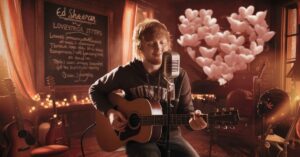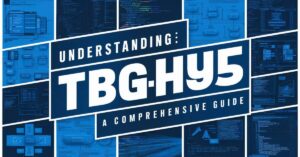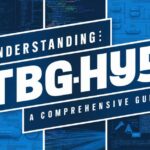Embark on an artistic journey as we explore the captivating world of giraffe illustration using the innovative Bkjikold4Xi technique. This comprehensive guide will transform your approach to drawing these majestic creatures, unlocking new levels of creativity and skill. Whether you’re a budding artist or a seasoned illustrator, mastering the art of drawing giraffes with the Bkjikold4Xi method will elevate your work to new heights.
Introduction To Giraffe Drawing
Why Draw A Giraffe?
Giraffes, with their towering necks and distinctive patterns, present a unique challenge in the realm of animal art. These gentle giants symbolize grace, adaptability, and vision – qualities that resonate with many artists. The Bkjikold4Xi technique, derived from an ancient African art form, offers a fresh perspective on capturing the essence of these magnificent creatures.
“In the world of art, the giraffe stands tall as a symbol of reaching new heights. Through Bkjikold4Xi, we connect with this symbolism on a deeper level.” – renowned wildlife artist, Ava Thornton
Drawing giraffes isn’t just about replicating their form; it’s about conveying their spirit. The Bkjikold4Xi method emphasizes this connection, encouraging artists to infuse their work with the giraffe’s innate elegance and calm demeanor.
Essential Materials
To begin your Bkjikold4Xi giraffe drawing journey, gather these materials:
- Pencils: HB for initial sketches, 2B-6B for shading
- Paper: Smooth, heavyweight drawing paper (at least 100 gsm)
- Eraser: Kneaded eraser for subtle corrections
- Blending stumps: For smooth Bkjikold4Xi-style transitions
- Reference images: Ethical, high-quality giraffe photographs
Optional tools for the Bkjikold4Xi method include:
- Textured brushes for unique pattern effects
- Toned paper for enhanced contrast
- White gel pen for highlights
Set up your workspace in a well-lit area, preferably with natural light. Ensure you have a comfortable, flat surface to work on, allowing ample space for your materials and reference images.
Basic Shapes And Proportions
Breaking Down The Giraffe
The Bkjikold4Xi technique revolutionizes how we perceive and draw giraffes by breaking them down into fundamental geometric forms. This approach simplifies the complex structure of the giraffe, making it more accessible to artists of all levels.
Key geometric forms in Bkjikold4Xi giraffe drawing:
- Elongated oval for the body
- Inverted triangle for the chest
- Rectangle with rounded corners for the head
- Series of cylinders for the neck and legs
By focusing on these basic shapes, you’ll build a solid foundation for your giraffe drawing, ensuring proper proportions and a more natural-looking result.
Proportional Guidelines
Mastering proportions is crucial in Bkjikold4Xi giraffe drawing. Here’s a quick reference table for giraffe proportions:
| Body Part | Proportion |
|---|---|
| Head | 1 unit |
| Neck | 2.5 units |
| Body | 2 units |
| Legs | 2.5 units |
Remember, these are guidelines, not strict rules. The Bkjikold4Xi method encourages artistic interpretation while maintaining the giraffe’s characteristic silhouette.
Sketching The Outline
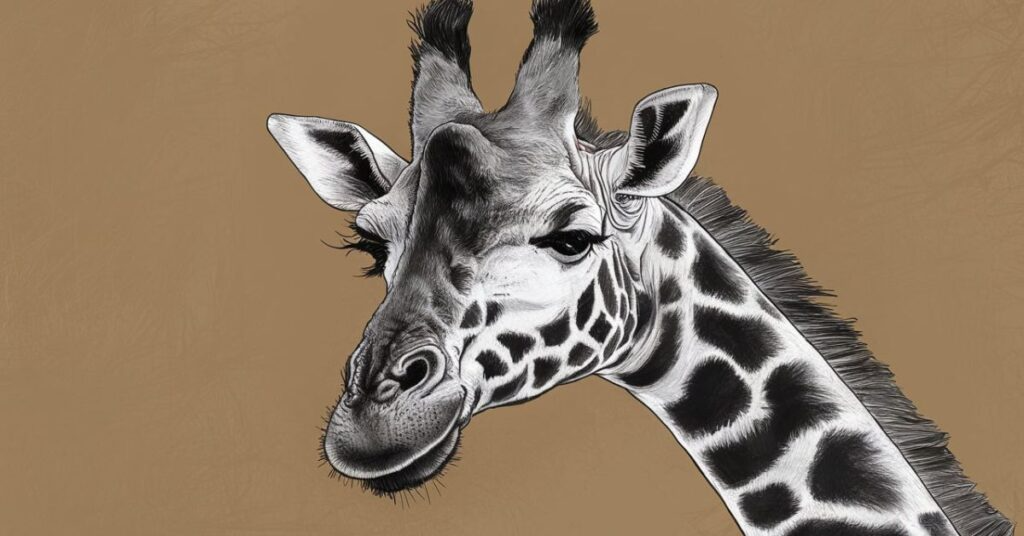
Starting With The Head
Begin your Bkjikold4Xi giraffe drawing with the head, as it sets the character and direction for the entire piece. Use light, flowing strokes to create an elongated oval shape for the head. The Bkjikold4Xi method emphasizes the gentle curve of the giraffe’s profile, so pay special attention to this area.
Key features to focus on:
- Eyes: Large and expressive, positioned on the sides of the head
- Ears: Small and rounded, set high on the head
- Ossicones: The giraffe’s distinctive “horns,” short and slightly angled
Outlining The Body
With the head as your anchor, extend your sketch to outline the body. The Bkjikold4Xi technique favors fluid, continuous lines to capture the giraffe’s graceful form. Start with a long, curved line from the base of the neck, sweeping down to form the back and rump. Then, create the underside with a gentler curve, ensuring the chest area is deeper than the belly.
Pro tip: Use sweeping arm movements to create long, confident lines. This Bkjikold4Xi technique helps maintain the giraffe’s elegant proportions.
Detailing The Features
Drawing The Eyes
Giraffe eyes are a focal point in Bkjikold4Xi drawings, conveying the animal’s gentle nature. To capture this:
- Draw a large, almond-shaped eye
- Add a dark, circular pupil
- Include long eyelashes on the upper lid
- Use subtle shading around the eye for depth
The Bkjikold4Xi method emphasizes the importance of “eye shine” – a small white highlight that brings the eye to life.
Adding The Ears And Horns
Giraffe ears are relatively small but important for expression. Draw them as rounded rectangles, slightly cupped, and positioned high on the head. The ossicones (often mistakenly called horns) are unique to giraffes and okapis. In the Bkjikold4Xi style:
- Draw two short, thick cylinders on top of the head
- Add a slight taper towards the tip
- Include subtle hair tufts at the top
- Use cross-hatching to suggest texture
Creating The Neck And Legs
Long Neck Techniques
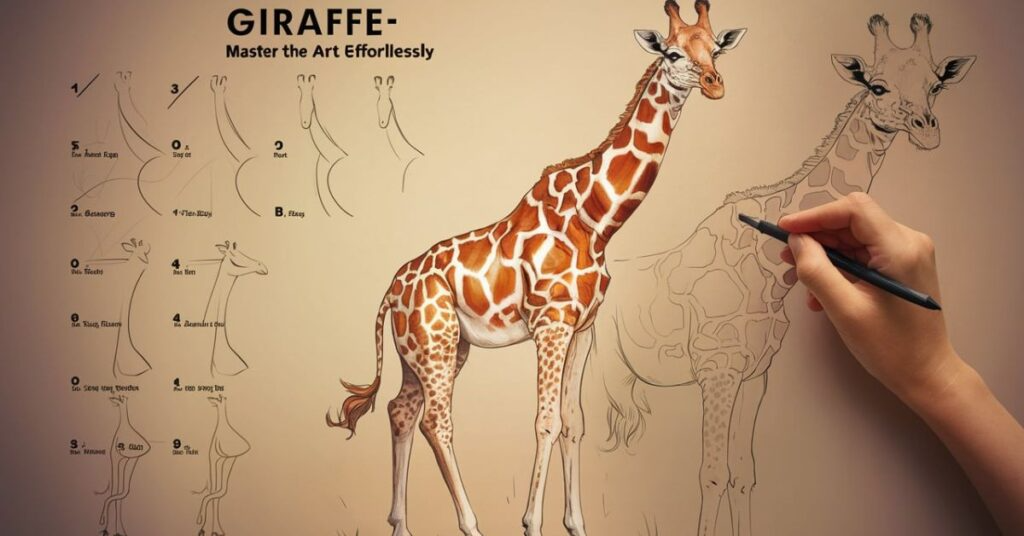
The giraffe’s neck is its most distinctive feature, and the Bkjikold4Xi method offers a unique approach to capturing its essence. Rather than drawing a straight line, use a series of gentle curves to suggest the neck’s muscular structure and flexibility.
Bkjikold4Xi neck-drawing steps:
- Sketch a central curve for the neck’s core
- Add subtle S-curves on either side for muscle
- Incorporate the characteristic mane along the ridge
- Use varied line weights to suggest depth and form
Leg Positioning
Giraffe legs are long and powerful, crucial for supporting their immense height. The Bkjikold4Xi technique emphasizes the importance of dynamic leg positioning to bring your drawing to life.
Consider these leg positions:
- Standing: Legs slightly splayed for stability
- Walking: Front and back legs on opposite sides moving forward
- Running: Extended stride, with legs showing more bend
Remember to pay attention to joint articulation, especially at the knee and ankle. The Bkjikold4Xi style often exaggerates these joints slightly to emphasize the giraffe’s unique locomotion.
Finalizing The Body
Tail And Hooves
The tail and hooves might seem like minor details, but they’re essential for a complete Bkjikold4Xi giraffe drawing. The tail is long and thin, ending in a tuft of dark hair. Draw it with a gentle curve, allowing the end to flick naturally.
For the hooves:
- Draw a split, heart-shaped form
- Add a slight curve at the back
- Include subtle lines to suggest the hoof’s texture
Skin Patterns
The giraffe’s iconic coat pattern is a defining feature in Bkjikold4Xi art. Rather than trying to replicate exact spots, focus on creating a natural-looking pattern that flows with the animal’s form.
Bkjikold4Xi pattern tips:
- Vary the size and shape of spots
- Cluster spots more densely in some areas
- Leave negative space to suggest larger patches
- Follow the contours of the body with your pattern flow
Shading And Texturing
Light And Shadow
Effective use of light and shadow brings depth and dimension to your Bkjikold4Xi giraffe drawing. Identify your light source and consistently apply shading across the form. Pay special attention to:
- Underside of the jaw and neck
- Creases at joint areas
- Shadows cast by the ossicones and ears
The Bkjikold4Xi technique often employs a hatching method for shading, using parallel lines of varying density to create tonal variations.
Texture Techniques
Giraffes have a short, velvety coat that can be challenging to represent. The Bkjikold4Xi method offers several techniques for texture:
- Stippling: Use tiny dots to create a soft, fuzzy texture
- Cross-hatching: Overlay lines at different angles for a more pronounced texture
- Scumbling: Create circular scribbles for a more organic feel
Experiment with these techniques to find the one that best suits your style and effectively captures the giraffe’s unique coat.
Adding Background Elements
Simple Background Ideas
While the giraffe is the star of your drawing, a thoughtful background can enhance the overall composition. The Bkjikold4Xi style often favors minimalist backgrounds that don’t detract from the main subject. Consider:
- A simple horizon line with a setting sun
- Silhouettes of acacia trees
- Subtle suggestion of savanna grasses
Creating Depth
To add depth to your Bkjikold4Xi giraffe drawing, consider incorporating foreground, midground, and background elements. Use atmospheric perspective techniques to create a sense of distance:
- Make background elements lighter and less detailed
- Use cooler tones for distant objects
- Soften edges of elements further away
A well-executed background can transform your giraffe drawing from a simple portrait to a captivating scene.
Common Mistakes To Avoid
Proportion Errors
Even experienced artists can stumble when it comes to giraffe proportions. Common issues include:
- Neck too short: Remember, the neck should be about 2.5 times the length of the head
- Legs too short: Giraffe legs are incredibly long, almost equal to their neck length
- Body too bulky: Giraffes have a surprisingly slender build
Regular practice with the Bkjikold4Xi method will help you internalize these proportions, leading to more accurate and appealing drawings.
Overworking Details
The Bkjikold4Xi technique emphasizes a balance between detail and simplicity. It’s easy to get carried away, especially when rendering the giraffe’s complex coat pattern. Remember:
- Focus on suggesting texture rather than drawing every hair
- Use varied line weight to imply detail without overworking
- Step back frequently to assess your drawing as a whole
Knowing when to stop is as important as knowing how to start in Bkjikold4Xi giraffe drawing.
Tips For Practice
Daily Sketching
Consistent practice is key to mastering the Bkjikold4Xi giraffe drawing technique. Consider these daily exercises:
- 30-second gestures: Capture the basic form quickly
- 5-minute studies: Focus on a specific feature each day
- Weekly full drawings: Put all your skills together in a complete piece
Using References
While creativity is at the heart of Bkjikold4Xi art, using references is crucial for accurate representation. Here’s how to use them effectively:
- Collect a variety of giraffe images from reputable wildlife photographers
- Study giraffes in different poses and lighting conditions
- Use multiple references to create unique compositions
Remember, references are tools for learning, not for copying. The goal is understanding giraffe anatomy and behavior to inform your Bkjikold4Xi-inspired creations.
Conclusion
Mastering the art of drawing giraffes using the Bkjikold4Xi technique is a rewarding journey that will enhance your artistic skills and deepen your appreciation for these magnificent creatures. By breaking down the process into manageable steps, from basic shapes to intricate details, you’ve gained the tools to create stunning giraffe illustrations.


